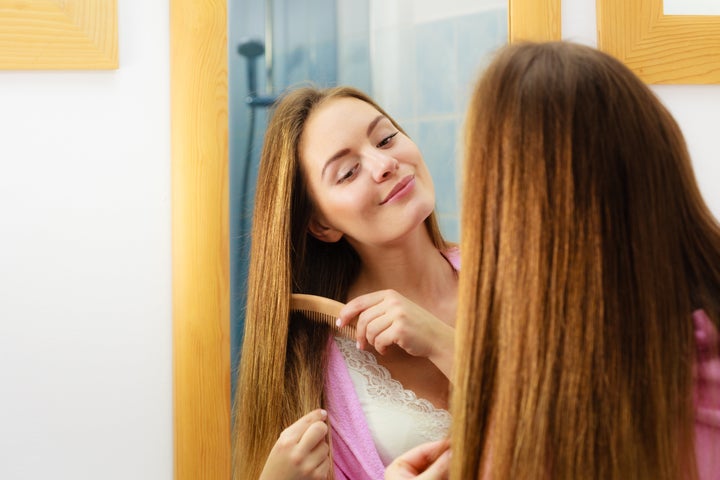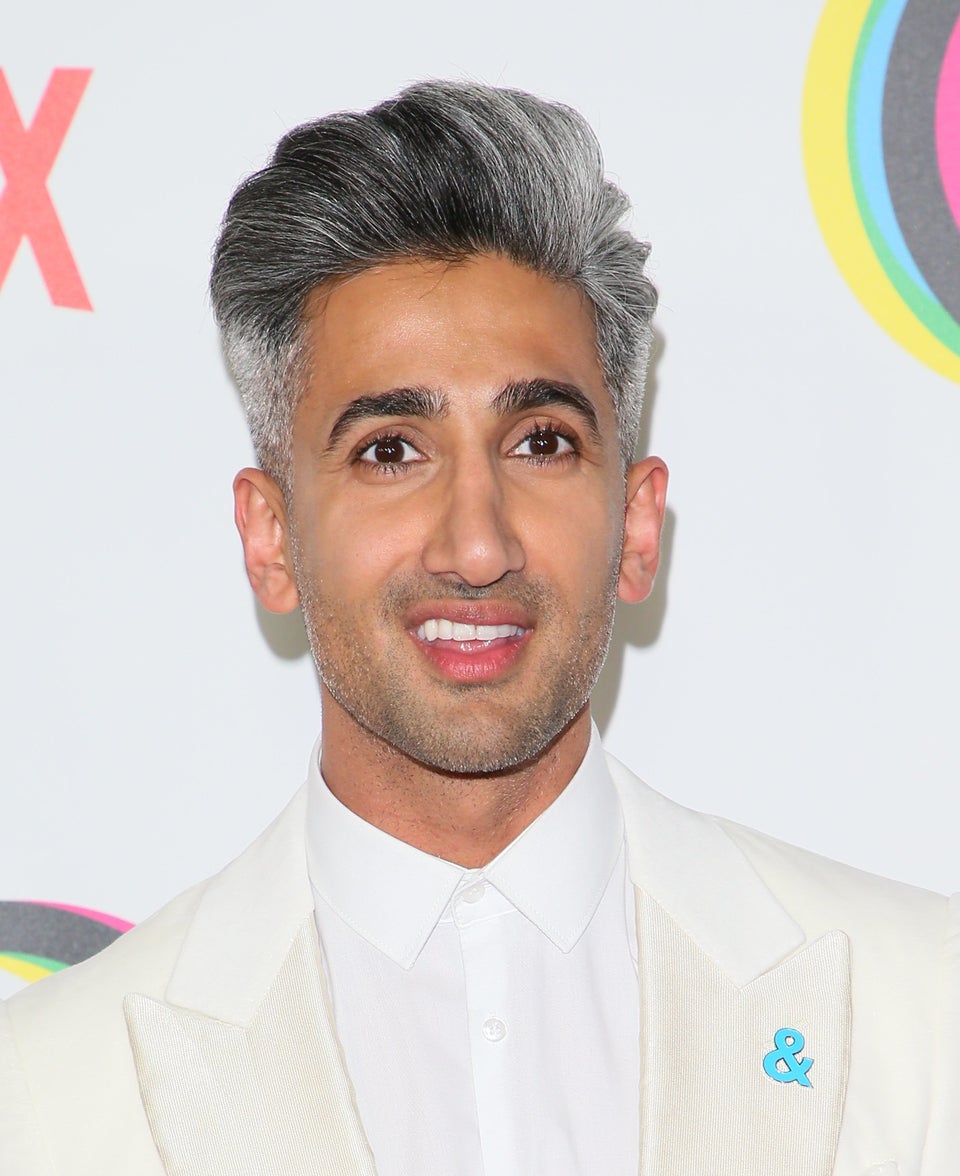
If there’s one thing we hate about summer weather, it’s humidity. Humidity equals frizz, and frizz is the worst.
Humidity is one of the top causes of frizz, but according to celebrity hairstylist Arsen Gurgov, it can also be caused by a few unexpected things (such as hot water, for example, but more on that later).
“Frizz is caused when hair is dry and lacks moisture,” Gurgov said. “When your hair is dry, the cuticle is rough, and when the weather is humid, it’s the perfect recipe for frizz. The outer layer of the hair takes in the moisture from the air, causing the hair to swell and frizz.”
The cuticle is made up of what looks like “little shingles,” said Dana Boyer, a New York-based hairstylist, adding that the cuticle layers should ideally lie flat, but they open up when damaged or exposed to moisture.
With countless anti-frizz products on the market, you’d think it would be easy to keep frizz at bay. But sometimes it feels like no matter how much stuff you put in your hair to stop it from going all Monica Geller on you, nothing works.
As it turns out, you might be part of the reason for your hair’s frizz. Below, check out the seven things you could be doing that actually make your hair frizzier.
1. Using products with sulfates
As “Queer Eye” star Jonathan Van Ness would tell you, “Them sulfates doin’ us dirty!!”
And Boyer agreed, saying sulfates ― strong detergents that are often added to shampoos ― have been shown to add frizz and dry out the hair. Sulfates can also strip hair of natural oils that keep it moisturized, according to Bustle.
There are plenty of brands making sulfate-free shampoos and conditioners, such as Shea Moisture, Moroccanoil, DevaCurl and OGX, many of which are available at drugstores.
2. Using products with alcohol
Products that contain alcohol can also dry out the hair, leaving it brittle and prone to frizz, Gurgov said. Brian Zinno, education director at Antonio Prieto Salon, agreed, adding that the alcohol actually absorbs the moisture your hair needs to combat frizz.
Instead, try using hair oils or styling cremes, which can help lock in moisture and keep hair looking shiny.
3. Washing your hair in super hot water
Zinno said washing your hair with very hot water can actually strip the hair of the natural oils that keep it moisturized and smooth. So, if you’re prone to frizz, you might want to try easing up on the heat.
4. Touching your hair too much
“Touching hair can create frizz if your skin has moisture in it,” Boyer said. Playing with your hair too much when it’s wet can also disrupt curl patterns or wave patterns, she added.
Gurgov suggested applying styling products to soaking wet hair “and then resist the urge to touch your hair until it’s completely dry. Otherwise, curls lose their definition and get frizzy.”
“The more you touch, the more frizz you create, so hands off!” he added.
5. Towel-drying your hair
Scrunching your hair up in a towel right after a shower may seem like a convenient way to dry it, but it won’t do you any favors when it comes to preventing frizz.
As hairstylist Kirsten Patterson said, towel-drying essentially roughs up the hair cuticle, which can cause it to lift up instead of lie flat.
“When your hair is wet, it is at its most fragile state,” Gurgov added. “Do not wrap your hair in a towel turban-style. If your hair is prone to frizz, invest in a microfiber towel to gently absorb excess moisture while keeping frizz at bay. Simply use the towel to blot the hair, then do not touch, and let it air dry.”
6. Overstyling with hot tools
“Whether you use a blow dryer, flat iron or curling iron, daily high heat from hair tools can damage the hair and strip it of moisture, leading to frizz,” Gurgov said. He suggested minimizing use of heated styling tools (if you can) and letting your hair air dry. If you do need to use heat, Gurgov said, use the lowest setting and always make sure to protect the hair with a thermal protectant spray before styling.
He also recommended using a blow dryer with ionic technology, which “produces natural negative ions to smooth the hair cuticle.”
Another way to prevent frizz if you’re using a blow dryer is to use the smoothing nozzle and blow dry in the direction of hair growth ― that is, from the roots to the ends ― to seal the cuticle, Patterson said.
7. Brushing it when it doesn’t need to be brushed
Brushing can help with untangling your locks, but it’s not always great for keeping frizz at bay, especially if you’re planning to skip the blow dryer.
As Zinno said, “On hair that you’re going to blow out, you do need to brush from root to tips to distribute naturally occurring scalp oils.”
But if you’re planning on letting your hair dry naturally, brushing it could just disrupt the outer layer and cause frizz, according to Gurgov. He also noted that brushing hair can actually stretch your strands and lead to breakage.
His tip: “When hair is wet, simply rake styling product through the hair with your fingers, and then hands off.”
If you’re brushing your hair while it’s dry, make sure you’re being gentle and not just “ripping through it,” Boyer said.
“If your hair texture allows it, I like to brush from scalp to ends with a hairbrush with both boar and nylon bristles,” she added. “It can help distribute oil from your scalp into your mid-lengths and ends, adding moisture and shine.”

So, what’s the RIGHT way to keep the frizz away?
If you’re trying to keep your hair looking shiny and smooth, all hope is not lost. The experts we spoke to had plenty of great tips. The first thing you need to do, however, is to identify your hair type, Boyer said.
“Is it fine? Curly or wavy? Damaged or dry? From there, you’ll be able to choose a product that is the most appropriate for your hair.”
For fine hair, Boyer noted that hairspray is often enough to tame frizz, while wavy and curly girls should opt for a creme or mousse to add moisture. If your hair is damaged, “repair can start in the shower,” she said. She also said she loves silk pillowcases and scarves for sleeping ― good for all hair types ― which can help decrease friction that causes frizz.
Gurgov recommended applying styling products to soaking wet hair, as opposed to towel-dried hair, “to add a protective layer against frizz.” He also said to use a leave-in conditioner “at least once a week to restore moisture and nourish dehydrated, frizzy hair.”
Argan oil is a good choice for adding weightless moisture and shine to hair, Gurgov said. “Unlike other oils, like coconut or olive, the oil molecules found in argan oil are small enough to penetrate the hair shaft, making it instantly, deeply moisturizing, which helps treat and strengthen strands without weighing them down.”
One ingredient you might want to avoid: silicone. Products with silicones can “create a barrier around the hair to prevent humidity from entering the cuticle and causing frizz,” Zinno said, but Gurgov and Patterson agreed they may not be the best option for everyone.
“Products with silicones, which are waxes, will keep frizz at bay, but they tend to build up with repeated use and coat the hair, making it flat, dull and lifeless,” Gurgov said.
Patterson added, “Silicone serums just coat the hair, giving the appearance of shine, but don’t actually add moisture to the hair strands to help fight frizz in the long run.”
